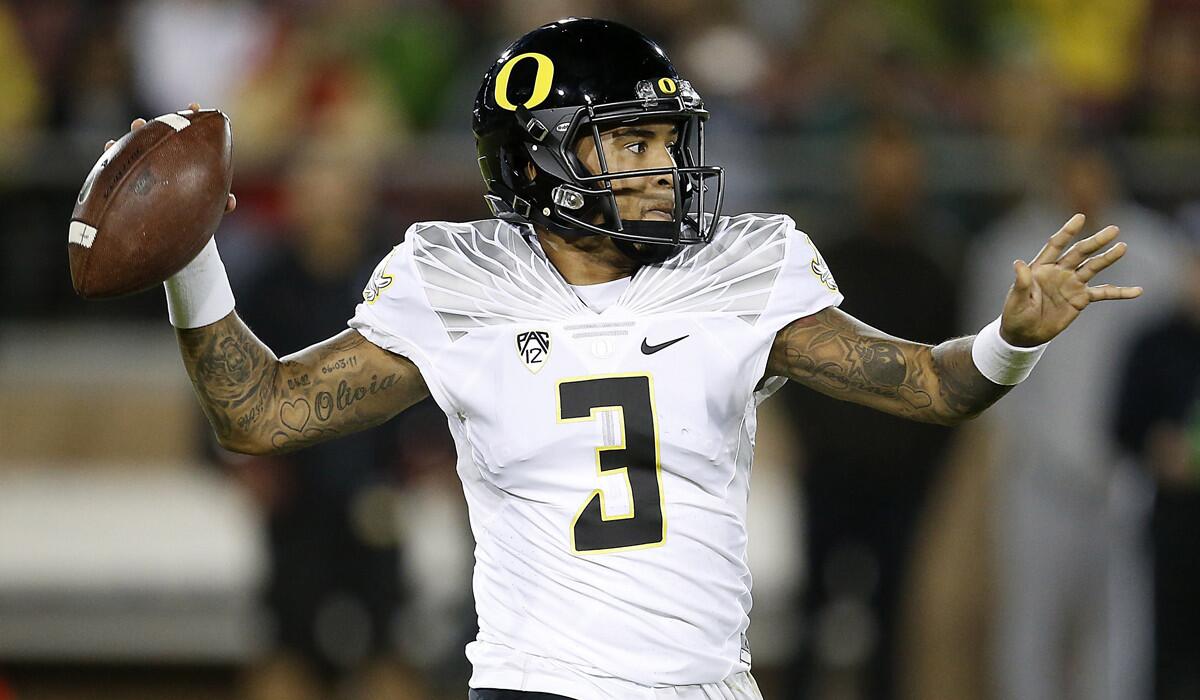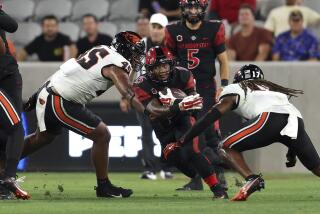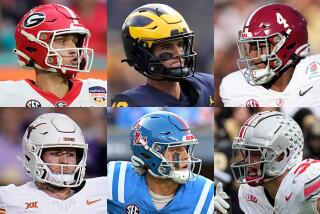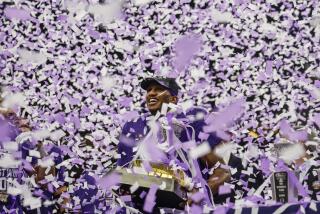Column: Injuries could play a big role in the college football playoff picture

Oregon quarterback Vernon Adams Jr. passes against Stanford last Saturday.
- Share via
The College Football Playoff committee’s warmup rankings are over and now it’s time to get serious.
Four losses in the top 10 last week exposed Baylor and Louisiana State and moved the Pac-12 Conference to comfortable balcony seats to watch the action below.
Two-loss teams were escorted out of top-10 contention by security guards while new faces stepped in to take their places.
But, wait, it’s not as black as it seemed Saturday for the Pac 12. It’s dark, but not black.
Stanford dropped eight spots to No. 15 in the USA Today coaches’ poll, which used to have a say in the title-picking matter, but only four spots to No. 11 in Tuesday’s only ranking that matters.
The selection committee is teasing Stanford like you would a cat with a goldfish.
This week’s top four did not change, even if there was some thought of handing over No.1 to one-loss Alabama.
Instead, the committee left Clemson at No. 1 despite a bumpy victory at Syracuse. Alabama remained solidly at No. 2, followed by Ohio State and Notre Dame.
Undefeated Iowa stayed at No. 5, followed by Oklahoma State, Oklahoma, Florida, Michigan State and Baylor.
Five through 10 has become a bar fight with the Big 12 Conference still trying to prove it belongs in the room.
The league has bet the playoff ranch house on a back-loaded schedule of key conference matchups.
“We’re seeing some of those teams emerging,” committee Chairman Jeff Long said in an ESPN interview staged between two ESPN basketball games.
The serious stuff begins now, with pivotal games breaking out all over the next two weeks.
A crucial component has emerged as the season moves toward the final crescendo: injuries. Notre Dame has survived them; UCLA, Oregon and others have not.
The four-team playoff, though, may hinge on how many top players can make it to the field.
Michigan State plays at Ohio State on Saturday not knowing how much quarterback Connor Cook’s tender shoulder will be a factor.
Oklahoma’s quest may be aided by the fact that Texas Christian, this week’s opponent, is tending to its top two players, quarterback Trevone Boykin and receiver Josh Doctson.
It happens. In 2012, remember, Notre Dame’s national title-game path was helped when USC quarterback Matt Barkley got knocked out the week before, against UCLA.
Sometimes, you get real lucky. In 2000, Oklahoma won the national title without a key injury suffered to a significant player. That seems almost impossible today.
Baylor’s national-title hopes were possibly snuffed after a season-ending injury to quarterback Seth Russell.
The benefactors were Oklahoma’s Sooners, who defeated Baylor last week in Waco, Texas.
The Pac-12 put four teams in the top 25 but none in the top 10.
Many in the league are understandably frustrated after its two top contestants, Stanford and Utah, were defeated last week (by two points and in double overtime).
UCLA Coach Jim Mora complained again Tuesday about late-night games hurting the league’s exposure in the East.
It’s all true, and a lot of it is a time-zone issue that can’t be resolved. Some of it, though, is the Pac-12’s decision to release control over time slots to the networks, in exchange for $3 billion.
“I don’t think nationally people realize exactly how good this conference is,” Mora said.
True, but the conference is a lot more respected than it used to be.
“I think we’re eating ourselves up a little bit,” Mora, whose team is coming off a last-second loss to Washington State, said. “You see some teams in some other conferences, late in the season before their big rivalry games, scheduling teams that are on a lesser level. We aren’t allowed to do that around here. It keeps it fun. It keeps it competitive.”
What conference could Mora possibly be referring to?
This week: Alabama is playing Charleston Southern, Auburn is playing Idaho, Kentucky is playing Charlotte, Florida is playing Florida Atlantic, South Carolina is playing The Citadel and Georgia is playing Georgia Southern.
The Southeastern Conference’s “advantage” is that it plays an eight-game league schedule, allowing it to soften treacherous stretches of the season with games against “teams that are on a lesser level.”
Playing weaker teams, the week before big rivalry games, allows SEC schools to rest starters.
Because Auburn has had a shockingly lousy season, the Nov. 28 game against Alabama isn’t going to be the game of the century. Both schools, though, were strategically setting up for that eventuality by scheduling cream puffs.
It’s almost like a bye week in advance of the Iron Bowl. And, of course, it’s still a crucial stretch for Alabama as it vies for playoff position.
Three more weeks remain in the season, which means three more chances for bedlam.
A playoff spot could even be decided in the “Bedlam Game,” Oklahoma at Oklahoma State on Nov. 28.
Times staff writer Chris Foster contributed to this report.
More to Read
Go beyond the scoreboard
Get the latest on L.A.'s teams in the daily Sports Report newsletter.
You may occasionally receive promotional content from the Los Angeles Times.











